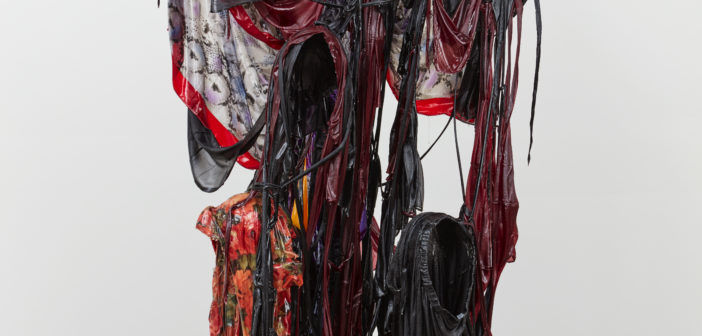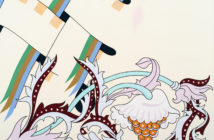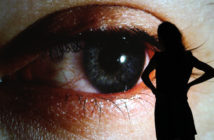Nike Air Jordan 1 shoes, durags, rain jackets, kaftans, mouth guards, feathers, fitted caps, microphones, sound effect processors, amplifiers, polyurethane foam, and resin are all materials Kevin Beasley focuses on to evoke the spectral traces of the past and present using sound, space, and signifiers of Blackness.

Kevin Beasley, Strange Fruit (Pair 1), 2015 Photo by Jean Vong © Kevin Beasley
Upon entering the gallery, viewers are greeted by Strange Fruit (Pair 1), an interactive sculpture suspended from the ceiling comprised of ropes from which a pair of Nike Air Jordan 1 shoes hang -- a nod to the urban tradition of flinging a pair of shoes on overhead electric wires, known as “shoe tossing.” Smothered in blood red polyurethane foam and resin, the dangling shoes invite the viewer to speak into a microphone which echoes on an amplifier embedded in the sculpture. The reverb effect produces a ghostly remnant resulting in the temporal effect of how what once was, now is. Strange Fruit (Pair 1) possess its own spirit, a word derived from the Latin term spiritus, meaning “breath.” Beasley invites audiences to activate the sculpture’s “spirit” by means of their own breath by exhaling and vocalizing into it. Even when the work is static, the acoustic feedback from the microphone produces an eerie crackle and fizz that animates it.
Beasley abstracts the physical Black body into wounded and fragmented forms in reference to Strange Fruit, a protest song written about the lynching of African-Americans in 1937 by Abel Meerepol. The song was later recorded and popularized by Blues titans Billie Holiday and Nina Simone, and recently sampled in Kanye West’s Blood on The Leaves. Commemorating America’s deep histories with lynching, lingering lineages of suffering, trauma, displacement, and subjugation, the sculpture is physically and sonically haunting, the color and texture suggestive of a disfigured and wounded body. The reverberated sounds emitted by the sound effect processors are eerie.
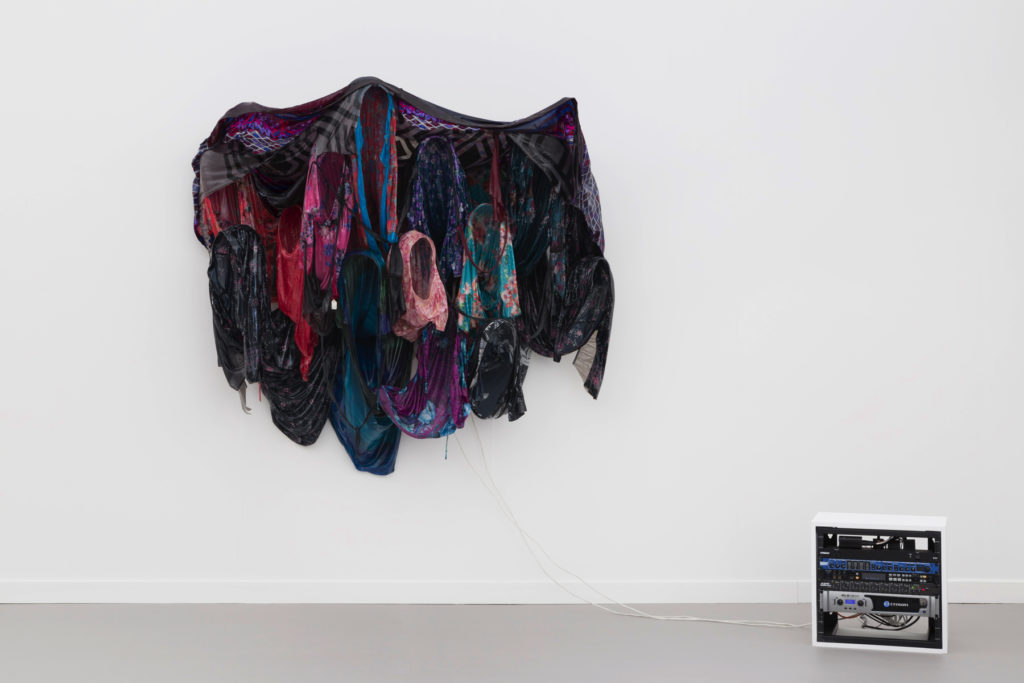
Kevin Beasley, Phasing (Ebb), 2017 Photo by Dawn Blackman © Kevin Beasley
Beasley also manipulates sound and space in Phasing (ebb), a wall mounted sculpture in the adjacent gallery. Composed of colorful house dresses, kaftans, and durags, the sculpture is delicate as the resin is casted and shaped to hold the vacuous bodily forms. Within the sculpture, a speaker disintegrates and emits sounds gathered from another gallery space in the museum, abstracting the experience of sound in real time.
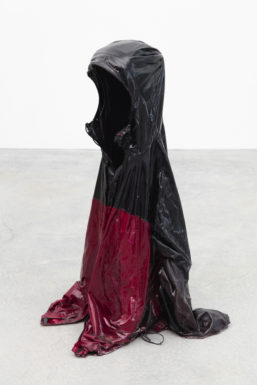
Kevin Beasley, Untitled (...just watch), 2015 Photo by Jean Vong © Kevin Beasley
Contemporary racial relationships in America are reflected upon in Untitled (…just watch), a free-standing hollow Nautica rain jacket, coated and held upright by resin. Minimized in height to approximately 45 inches from the floor, the jacket, which once belonged to Beasley in high school, suggests the body of a four or five-year-old child garbed in an adult sized jacket that droops down the shoulders. The diminutive scale brings to mind the recent killings of seventeen-year-old Trayvon Martin, twelve-year-old Tamir Rice, and seven-year-old Aiyana Jones. The form of the work, a hollow hooded figure, recalls David Hammon’s iconic, In The Hood (1993), and most recently, John Edmond’s Hood photographic series. In context with his contemporaries, Untitled (…just watch), examines the symbolic gestures of clothes as a marker of race and gender. The viewer is confronted by the aftermaths of slavery, systematic forms of injustices, and anti-blackness that have plagued the United States.

Kevin Beasley, A view of a reflection, 2017 Photo by Jason Wyche © Kevin Beasley
Beasley ambitiously uses scale to emphasize historical references in A view of a reflection (2017), a five-inch-thick and 15-foot long slab that is an amalgamation feathers, mouth guards, t-shirts, socks, durags, fitted caps all encapsulated in resin. Inspired by the 9th Century BCE Assyrian reliefs at the Pergamon Museum in Berlin, Beasley engages with the preservation of personal items from contemporary culture. On the top left of the thick slab is a brown radial resin form that appears to be inserted into the relief. Colors from the garments and fabrics clash, and from a distance the work imitates a landscape, perhaps an ocean with its dominant blue waves or a night scene with the moon illuminating a pastoral scene.
Beasley chooses his objects for their personal connection to him or someone he knows. In an interview with American-artist Mark Bradford in the exhibition catalogue, Beasley describes his interests in materials as “an expanding aspect of my practice, because as much as I enjoy the technical understanding of how these things come together, I am constantly questioning what can be a viable material to use … So I am constantly thinking about how I get to an understanding of my surroundings in all of their nuances.” By dislocating sound and moulding clothing to leave the haunting traces of bodies, Beasley turns these personal, contemporary materials into ancient artifacts to represent the body and cultural experiences of young black men.
Kevin Beasley is on view at the ICA Boston through August 26, 2018.

